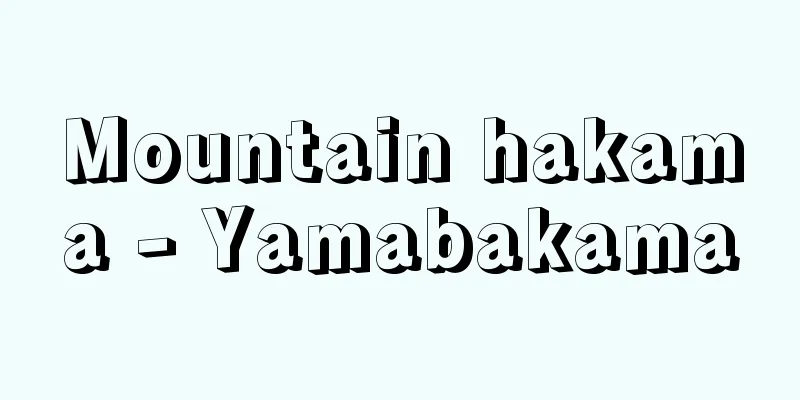Mountain hakama - Yamabakama

|
A general term for hakama worn by farmers in rural areas while working. A counter term to zashiki hakama. Depending on the region, various words are used for this hakama, such as monpe, karusan, tattsuke, susoboso, detachi, and sharen. They are all characterized by having four pieces and a gusset. Generally, the main material is cotton with vertical stripes, followed by kasuri. They generally do not have a waistboard, and when putting on the hakama, the back is pulled down slightly and tied with a string. The composition of the clothing varies from one to another; the "sashigi" is derived from the samurai's "tattsuke" style and is characterized by a habaki sewn to the bottom of the four-width hakama, while the "karusan" style was named after its resemblance to the hakama worn by the Nanban people. "Susohasao" is a style of hakama that narrows towards the bottom. "Detachi" means hakama worn when going out and standing, while "pun" comes from the phrase "please wait a moment" and was used on the border between Miyagi and Fukushima prefectures. In the Aizu region, "saruppe" means "sarubakama," which means the kind of hakama worn by monkeys in monkey shows. All of these styles have names and forms that are rich in local color, and their meanings are complex. The kimono worn by Iga ninjas in the Edo period were called Iga hakama, and the Egawa hakama invented by Egawa Tarozaemon, who led peasant soldiers in preparation for emergencies at the end of the Edo period, was also a variation of the Yama hakama. The Yama hakama, a clothing accessory that developed with regional characteristics, is said to have hundreds of names. [Takeshi Endo] [Reference] | |©Katsuya Nishikawa "> Main types of Yamabakama Source: Shogakukan Encyclopedia Nipponica About Encyclopedia Nipponica Information | Legend |
|
農山村の農民が仕事をする際に着用する袴の総称。座敷袴に対する語。この袴は地方により、もんぺ、かるさん、裁着(たっつけ)、裾細(すそぼそ)、でたち、またしゃれなど、さまざまのことばが使われている。いずれも4枚はぎと襠(まち)があるのが特色。材料は総じて木綿の縦縞(たてじま)が主で、絣(かすり)はその次である。だいたいは腰板がなく、袴をはく際には後ろをすこし引き下げて紐(ひも)で結ぶ。 その被服構成にはそれぞれ相違があり、裁着は、武士の立付(たっつけ)から転じたもので、四幅(よの)袴の裾(すそ)に脛巾(はばき)を縫合させたところに特色があり、かるさんは、南蛮人の袴に類似しているところから名づけられたものである。裾細は、袴の裾にいくにつれて細くなった仕立て。でたちは、出て立つときに着用するという袴の意、またしゃれは、「ちょっとお待ちください」という語から出たもので、宮城・福島県境で用いられた。会津地方で、山袴をサルッペというのは、猿袴(さるばかま)のことで、猿回しの猿がはくような袴の意である。いずれも郷土色豊かな名称と形態をもつもので、その内容は複雑である。 江戸時代伊賀者がはいた裁着は、伊賀袴といわれたり、幕末に農兵を率いて非常時に備えた江川太郎左衛門考案の江川袴も山袴の変型である。その郷土的特色をもちながら発達した服飾品の山袴は、名称だけでも数百に及ぶとされている。 [遠藤 武] [参照項目] | |©西川勝也"> 山袴のおもな種類 出典 小学館 日本大百科全書(ニッポニカ)日本大百科全書(ニッポニカ)について 情報 | 凡例 |
>>: Yamaha Corporation - Yamaha
Recommend
LCU - El C You
...(a) A craft that beaches and lowers a diagonal...
New York City Ballet
An American ballet company with Lincoln Kirstein (...
Titanium metal
… [titanium] Of all the light metals, titanium is...
Chronicles of the Khitan Kingdom
A Chinese history book in 27 volumes. Compiled by ...
SMSA - Small Scale Manufacturing Service
Standard metropolitan statistical area : A statist...
Nanao [city] - Nanao
A city in the eastern part of the Noto Peninsula i...
Cho Bongam - Cho Bongam
1898‐1959 South Korean politician. Born on Ganghwa...
Musicescu, G. (English spelling) MusicescuG
...The works of Hieronimus Ostermayer (1500-1861)...
IGSN71 - IGSN
… [Gravity Reference Net] While the normal gravit...
Alexander Halensis
Around 1185 - 1245 Franciscan theologian from Engl...
Calystegia hederacea (English spelling) Calystegiahederacea
… [Mitsuru Hotta]... *Some of the terminology tha...
Treasure Collection
A collection of Buddhist tales from the early Kam...
Grass sieve - Grass sieve
…A fixed weir is a weir without a gate, built to ...
Palpebral fissure - Gunkenretsu
Upper and lower eyelids ( Eyelids Hard work The jo...
Anti-Federalists
In this situation, the supporters of the proposed...









